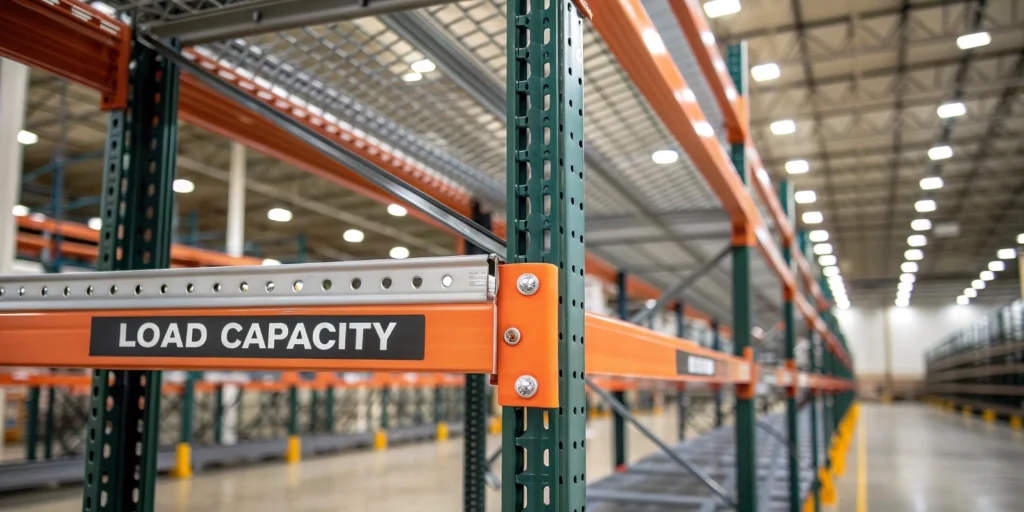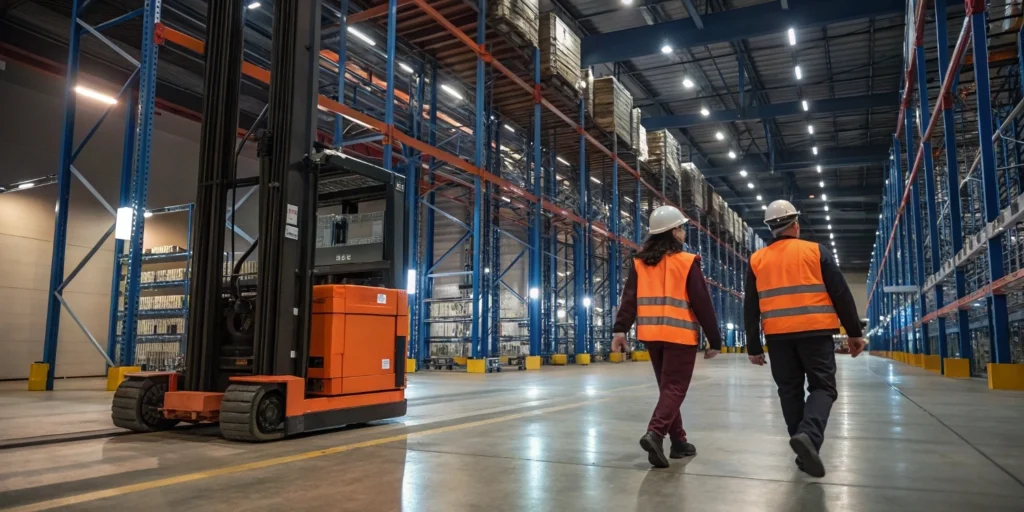
Table of Contents
Maximize Your Warehouse Potential with High Bay Storage Solutions
Every inch of your warehouse floor matters. But what about the vertical space above your racks and aisles? That untapped zone could be the key to streamlining your operations, cutting costs, and boosting your storage capacity. High bay storage systems do more than just add height—they redefine efficiency, offering a threefold increase in usable space while maintaining stability and safety at the core.
As someone managing inventory flow, facility design, or logistical throughput, you’ve likely faced the challenge of overcrowded racking or an ever-growing SKUs list. High bay storage gives you the flexibility to scale upward, not outward.
What Is High Bay Storage and Why It Matters
High bay storage refers to pallet racking systems that typically extend over 12 meters in height. These systems utilize vertical space for storing palletized goods in multiple levels, often up to 50 meters high in advanced installations. You can choose between manual systems operated by forklifts or fully automated setups using stacker cranes and warehouse management systems (WMS).

Why You Should Care:
- Increases storage capacity without expanding the building footprint
- Ideal for high-volume, fast-turnover inventory
- Reduces clutter and improves inventory visibility
- Can be configured to suit various industries and operational workflows
Whether you’re in e-commerce, cold storage, or manufacturing, high bay storage can adapt to your product mix and throughput requirements.
Key Technical Features of High Bay Storage Systems
Understanding the core components of high bay systems helps you make better purchasing and planning decisions. Here’s a breakdown of the typical specs you should evaluate:
Technical Specs Overview
| Feature | Typical Range | Benefit |
|---|---|---|
| Height | 12–50 meters | Maximizes vertical space |
| Load Capacity per Bay | 500–1500 kg | Supports heavy-duty goods |
| Automation Integration | Optional (AS/RS compatible) | Boosts throughput & accuracy |
| Construction Material | Steel or hybrid systems | Long-term durability |
| Safety Features | Mesh, fencing, sensors | Personnel and product protection |
Structural Design Elements
- Modular upright frames with bracing for seismic loads
- Narrow aisle configurations to enable denser layouts
- Fire-resistant coatings and sprinkler integration
By tailoring your design to suit these specifications, you ensure your racking system remains compliant and scalable.
How High Bay Storage Achieves 3x Space Efficiency
Verticality changes the game. Traditional pallet racking consumes large floor areas. In contrast, high bay storage leverages ceiling height, multiplying your capacity without the overhead of additional square footage.

Vertical Storage Optimization
- Reduces the number of aisles needed, freeing up more racking space
- Allows you to consolidate inventory in fewer facilities
- Makes use of underutilized cubic volume
Integrated Automation Benefits
Automated storage and retrieval systems (AS/RS) reduce the need for wide aisles and manual handling.
- High-density stacking in tighter layouts
- Eliminates dead space between rack levels
- Increases picking speed and accuracy by up to 40%
With smart vertical strategies, your warehouse could hold triple the volume without relocating.
Safety Advantages That Keep Your Operation Steady
When systems scale in height, risk factors also rise. High bay storage tackles these challenges with built-in safety engineering.
Active & Passive Safety Mechanisms
- Anti-collapse mesh prevents falling goods in seismic or accidental impact events
- Guided forklift lanes or automated tracks reduce human error
- Sensors and WMS alerts warn operators of obstructions or overloads
Lower Injury Rates
By minimizing manual lifting and repetitive strain, these systems reduce workplace injuries. And with automation, you also decrease forklift traffic—one of the leading causes of warehouse accidents.
Stability in Harsh Conditions
If you’re operating in cold storage or high-humidity environments, you can customize your high bay racking with:
- Corrosion-resistant finishes
- Fire protection systems
- Reinforced joints for extreme temperatures
Stability and safety should never be trade-offs for storage density—with the right system, you don’t have to choose.
Cost Savings & ROI of High Bay Storage
You might assume high bay systems are capital intensive—and they can be. But when viewed from an operational perspective, their return on investment (ROI) is often faster than expected.
Operational Cost Benefits
- Reduced land costs: Build upward, not outward
- Lower energy use: Compact layouts minimize lighting and HVAC needs
- Fewer labor hours: Automation replaces repetitive tasks
Financial Impact Breakdown
| Investment Area | Short-Term Cost | Long-Term Gain |
| Construction & Racking | High | Lower property and lease costs |
| Automation Equipment | Moderate to High | Reduced labor and inventory losses |
| Maintenance & Upkeep | Low | Prolonged lifespan and fewer repairs |
By centralizing inventory and improving order processing speeds, high bay racking can significantly reduce operating expenses.
Best Practices for High Bay Storage System Implementation
To ensure a smooth transition and long-term value, consider the following implementation strategies:
Planning Phase
- Evaluate your building’s ceiling height, fire safety codes, and floor load capacities
- Conduct simulations using CAD layouts and traffic flow models
- Pre-plan for future expansion with modular designs
Execution Phase
- Schedule phased installations to avoid major disruptions
- Integrate with your WMS for real-time inventory tracking
- Conduct rigorous testing on load capacity and safety systems
Maintenance & Training
- Set quarterly inspection schedules
- Train staff on equipment use, emergency protocols, and basic troubleshooting
- Keep spare parts on hand for mission-critical components
Structured execution reduces downtime, enhances safety, and maximizes your long-term gains.
Real-World Use Cases and Industry Applications
High bay systems are not one-size-fits-all. Their flexibility makes them suitable for a variety of sectors:

Industry Applications
- 3PL & Logistics: For fast-moving consumer goods (FMCG) and e-commerce hubs
- Cold Chain Warehousing: Ideal for food, pharma, and perishables with space-limited environments
- Manufacturing: Stores raw materials, components, and finished goods in sequence
- Automotive & Aerospace: Manages heavy-duty, high-value inventory
Case Study Snapshot
A global beverage distributor implemented a high bay AS/RS system and reduced warehouse space by 60%, while tripling their order fulfillment speed.
Innovative Trends in High Bay Storage
You can stay competitive by aligning with emerging technologies shaping the future of warehousing:
Future-Focused Enhancements
- AI-Powered WMS: For predictive picking and inventory rebalancing
- Drones: For remote visual inspections of tall racks
- IoT Sensors: Real-time data on rack integrity and environmental conditions
- Green Storage: Systems designed for energy efficiency and low carbon footprints
Adopting these innovations gives your facility not only a performance boost but also a sustainability edge.
Frequently Asked Questions (FAQ)
What is high bay storage and how is it different from standard pallet racking?
High bay storage refers to racking systems over 12 meters tall that optimize vertical space. Standard racks are shorter and offer less capacity.
Do I need automation to implement high bay systems?
No, you can use manual forklifts or semi-automated systems. However, automation improves safety and efficiency significantly.
How much space can I really save?
You can achieve up to 3x the storage density using high bay configurations versus conventional layouts.
Is it worth the investment?
Absolutely. The initial cost is offset by long-term savings in labor, space, and operational throughput.
Build Smarter, Store Higher, Operate Safer
High bay storage isn’t just about taller racking—it’s about rethinking how your warehouse operates. You get more space, stronger safety, and sharper efficiency, all while reducing your overall costs. When your storage system aligns with your operational goals, every pallet becomes more profitable.
Now is the time to elevate your facility’s potential. If you’re ready to future-proof your storage infrastructure with a steady, safe, and space-efficient solution, reach out to our team. Let’s engineer a system that grows with you.
Need a custom solution or site audit? Contact us today and let our engineers help you unlock the power of vertical storage.



